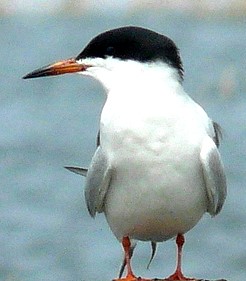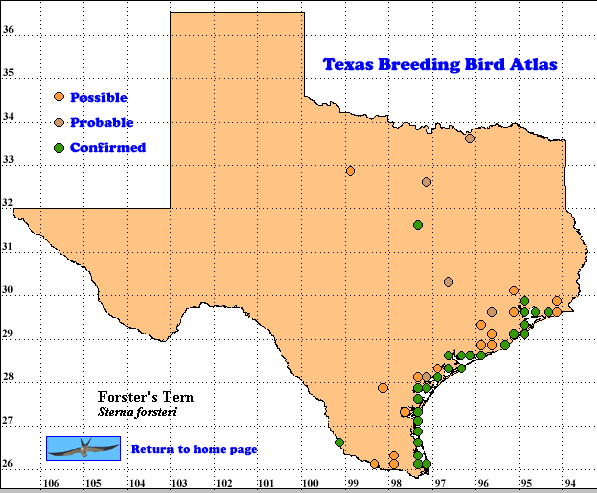Forster’s Terns are the only terns restricted to the New World with most of these birds breeding in North America. They were originally considered a variant of Common Tern (S. hirundo), but this error was corrected by Coues. These terns were given the name proposed earlier by Nuttall which honored a German naturalist, Johann Forster. Although Forster’s Terns are similar in size and plumage to Common, Arctic (S. paradisaea) and Roseate (S. dougallii) terns, genetic analysis suggests Forster’s Terns are most closely related to the larger Royal Tern (S. maxima; McNicholl et al. 2001).
The primary food items of Forster’s Terns are small fish, captured by plunge-dives typical of terns. They also consume arthropods such as dragonflies, captured in mid-air or plucked from water surfaces. In courtship feeding, males present small fish to prospective mates. (Bent 1921, McNicholl et al. 2001).
DISTRIBUTION. During the 1987-1992 field work seasons of the TBBA project, atlasers found 134 confirmed, 13 probable and 53 possible nesting sites for Forster’s Terns, primarily on or near the coast in the Coastal Prairies, Coastal Sand Plain and South Texas Brush Country regions with a few in the Oak Savanna and Blackland Prairies (see the region map in Lockwood and Freeman [2004]).
North American Breeding Bird Survey (BBS) data indicate relative abundances of 3-10 terns per route along the Texas coast, in the Klamath Basin of Oregon and California and near Great Salt Lake in Utah (Sauer et al. 2008). Breeding has been reported in suitable habitats from southern Canada to northern Mexico. The species primarily winters from the Gulf Coast and Mexican border area to southern Mexico and the northern West Indies (Howell and Webb 1995, Am. Ornithol. Union 1998, McNicholl et al. 2001).
SEASONAL OCCURRENCE. Forster’s Terns are residents along the coast and common and widespread migrants in Texas. Spring migrants are present from late March to early June, while summer residents breed from early April to mid-July, as suggested by egg collection dates from April 12 to June 10 and dependent young present as late as July 11. Fall migrants are most common from late July to late October. In winter Forester’s Terns are found in much higher numbers along the coast than in summer and are the most common species of terns on inland reservoirs (Oberholser 1974, Lockwood and Freeman 2004).
BREEDING HABITAT. In Texas Oberholser (1974) reported Forster’s Terns breeding near sea level on grassy islands in coastal bays. Across North America these terns breed primarily in salt, brackish or freshwater marshes, including marshy borders of lakes, islands, or streams. These terns are colonial breeders with nests placed close together. Coastal nests are usually elaborate, well-constructed piles of dead grass and sedges, lined with fine grass and reeds. The outside diameter ranges from 51 to 76 cm (20-30 in), inside diameter 18-20 cm (7-8 in) and depth 2.5-4 cm (1-1.5 in). Nests inland are built on varied supports: including muskrat houses or floating mats or emergent vegetation. They are much simpler than coastal nests (Harrison 1979, McNicholl et al. 2001).
In these nests females usually lay 3 (range 1-4), smooth, dull, olive to buff eggs at 1-2 day intervals. The eggs, marked with numerous small spots, blotches or crooked lines of dark brown, are shown in a photo in Harrison (1979). Incubation, which starts after the first egg is laid, lasts 23-26 days with both parents participating. The semi-precocial young are fed and brooded by their parents in the nest. Chicks called by adults may leave the nest at 4 days old, but can not fly until 4-6 weeks old. Young able to fly were observed being fed by adults. Only one brood is raised per year (Harrison 1979, McNicholl et al. 2001).
STATUS. Forster’s Terns are common residents along the Texas coast (Lockwood and Freeman 2004). The coastal breeding sites on the TBBA map are consistent with the distribution of breeding records on Oberholser’s (1974) map, but the inland breeding sites are apparently newer. They corroborate reports of inland breeding in Lockwood and Freeman (2004). BBS data from 11 Texas routes suggest an annual population decrease of 8%, much larger than the approximately -1% change for North America (Sauer et al. 2008). Further study of population trends of Forester’s Terns is needed.
Text by Robert C. Tweit (2008)
Literature cited.
American Ornithologists’ Union. 1998. Checklist of North American birds, 7th ed. Am, Ornithol. Union, Washington, DC.
Bent, A. C. 1921. Life histories of North American gulls and terns. U. S. Nat. Mus. Bull 113, Washington, DC.
Harrison, H. H. 1979. A field guide to western birds’ nests. Houghton Mifflin, Boston, MA.
Howell, S. N. G. and S. Webb. 1995. A guide to the birds of Mexico and northern Central America. Oxford University Press, New York.
Lockwood, M. W. and B. Freeman. 2004. The TOS handbook of Texas birds. Texas A&M University Press, College Station.
McNicholl, M. K., P. E. Lowther and J. A. Hall. 2001. Forster’s Tern (Sterna forsteri), The Birds of North America Online (A. Poole, Ed.). Ithaca: Cornell Lab of Ornithology; Retrieved from: http://bna.birds.cornell.edu/bna/species/595
Oberholser, H. C. 1974. The bird life of Texas. University of Texas Press, Austin.
Sauer, J. R., J. E. Hines, and J. Fallon. 2008. The North American breeding bird survey, results and analysis 1966-2007. Version 5.15.2008. USGS Patuxent Wildlife Research Center, Laurel MD < http://www.mbr-pwrc.usgs.gov/bbs>

